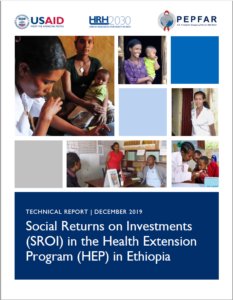30 Mar Social Returns on Investments (SROI) in the Health Extension Program (HEP) in Ethiopia
 In 2004/5, Ethiopia created an innovative community-based health extension program (HEP) to improve access to health services, especially in rural and medically underserved areas. Through the national HEP, community members—mostly women aged 18 years or older with at least a 10th grade education—are selected to undergo a 12-month or longer training to become health extension workers (HEWs).
In 2004/5, Ethiopia created an innovative community-based health extension program (HEP) to improve access to health services, especially in rural and medically underserved areas. Through the national HEP, community members—mostly women aged 18 years or older with at least a 10th grade education—are selected to undergo a 12-month or longer training to become health extension workers (HEWs).
While the health benefits of investing in community healthcare, including in the HEP, are increasingly known, there has been little analysis about the impact on inclusive economic growth. Traditional return on investment studies only show monetary returns from capital investments and their contributions to health service cost savings. To fill this gap, HRH2030 conducted a study of the health, social, employment, and equity returns associated with increased health service utilization to estimate the social return on investment (SROI), especially for underserved and hard-to-reach populations, from the HEP.
Our findings showed that the social return on investment in HEP is between $1.54 and $3.26 for every dollar invested and greater than one in all four of the regions studied (Tigray, Oromia, the Southern Nations, Nationalities, and People’s region [SNNP], and Amhara), indicating that the HEP’s economic benefits exceed Ethiopia’s investment in the program. The highest returns are shown in Tigray ($1.87-$4.64) and Amhara ($1.88-$3.86), with lower returns in SNNP ($1.43-$3.82) and Oromia ($1.35-$2.35). HEP produces substantial economic benefits of almost $7,000 to $14,500 per HEW per year.
The study also showed that across all categories of clinical and non-clinical services, a total of 50,699 maternal and child lives were saved by HEP between 2008 and 2017. This included 2,500 lives saved for PMTCT. These results show that the HEP, while producing substantial economic benefits in Ethiopia, is also having important impact on maternal and child health.
The full report (shown above) and a two-page summary are available for download, below.
Country: Ethiopia
Resource Type: Technical report; brief
Topic: Build Sustainability of Investment in the Health Workforce





